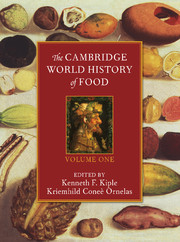Book contents
- Frontmatter
- Introduction
- Part I Determining What Our Ancestors Ate
- Part II Staple Foods: Domesticated Plants and Animals
- II.A Grains
- II.B Roots, Tubers, and Other Starchy Staples
- II.C Important Vegetable Supplements
- II.D Staple Nuts
- II.E Animal, Marine, and Vegetable Oils
- II.E.1 An Overview of Oils and Fats, with a Special Emphasis on Olive Oil
- II.E.2 Coconut
- II.E.3 Palm Oil
- II.E.4 Sesame
- II.E.5 Soybean
- II.E.6 Sunflower
- II.F Trading in Tastes
- II.G Important Foods from Animal Sources
- Part III Dietary Liquids
- Part IV The Nutrients – Deficiencies, Surfeits, and Food-Related Disorders
- References
II.E.1 - An Overview of Oils and Fats, with a Special Emphasis on Olive Oil
from II.E - Animal, Marine, and Vegetable Oils
Published online by Cambridge University Press: 28 March 2008
- Frontmatter
- Introduction
- Part I Determining What Our Ancestors Ate
- Part II Staple Foods: Domesticated Plants and Animals
- II.A Grains
- II.B Roots, Tubers, and Other Starchy Staples
- II.C Important Vegetable Supplements
- II.D Staple Nuts
- II.E Animal, Marine, and Vegetable Oils
- II.E.1 An Overview of Oils and Fats, with a Special Emphasis on Olive Oil
- II.E.2 Coconut
- II.E.3 Palm Oil
- II.E.4 Sesame
- II.E.5 Soybean
- II.E.6 Sunflower
- II.F Trading in Tastes
- II.G Important Foods from Animal Sources
- Part III Dietary Liquids
- Part IV The Nutrients – Deficiencies, Surfeits, and Food-Related Disorders
- References
Summary
Oils from vegetable sources are playing an increasingly important role in human nutrition, and they, along with foods incorporating them, currently compose 30 percent of the calories in a typical Western diet. In the past, however, vegetable oil utilization was limited, and animal and marine fats were far more important. This chapter discusses the nutritional value of fats and oils widely used in the world today.
Fatty Acid Nomenclature
Most oils consist primarily of triacylglycerols, which are composed of 3 fatty acids esterified to a glycerol molecule. The “essential” fatty acids are a major consideration in assessing the nutritional value of fats and oils. G. O. Burr and M. M. Burr first discovered that fats and oils contained substances that were essential for normal growth and reproduction (Holman 1992), and in the 1970s, convincing evidence was presented to show that the omega-3 fatty acids were also essential in humans. In addition to fatty acids, other components present in fats and oils include fat-soluble vitamins (A, D, and E) and sterols, and as few other compounds in fats and oils are of nutritional importance, only fatty acids, fat-soluble vitamins, and sterols are discussed in this chapter.
The sterols of importance to nutrition include cholesterol and the plant sterols. The structures of common sterols are shown in Figure II.E.1.1. Recently, there has been a great deal of interest in cholesterol oxides, which are formed in cholesterol-containing foods and oils after heating or oxidation and which have been implicated in the development of atherosclerosis (Smith 1987; Nawar et al. 1991).
- Type
- Chapter
- Information
- The Cambridge World History of Food , pp. 375 - 388Publisher: Cambridge University PressPrint publication year: 2000
References
- 4
- Cited by

